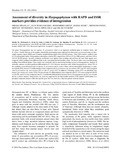Please use this identifier to cite or link to this item:
http://hdl.handle.net/10311/1425| Title: | Assessment of diversity in Harpagophytum with RAPD and ISSR markers provides evidence of introgression |
| Authors: | Muzila, Mbaki Werlemark, Gun Ortiz, Rodomiro Sehic, Jasna Fatih, Moneim Setshogo, Moffat Mpoloka, Wata Nybom, Hilde |
| Keywords: | Harpagophytum |
| Issue Date: | 2014 |
| Publisher: | Mendelian Society of Lund, http://www.hereditasjournal.com/ |
| Citation: | Muzila, M. et al. (2014) Assessment of diversity in Harpagophytum with RAPD and ISSR markers provides evidence of introgression, Hereditas, Vol. 151, No. 4-5, pp. 91-101 |
| Abstract: | The genus Harpagophytum has two species: H. procumbens which is an important medicinal plant in southern Africa, and H. zeyheri. Genetic diversity in 96 samples, obtained by germinating seeds collected from Botswana, was assessed using six intersimple sequence repeat (ISSR) and 10 random amplified polymorphic DNA (RAPD) primers. These DNA markers yielded a total of 138 polymorphic bands. Polymorphism information content (PIC) ranged from 0.06 to 0.39 for ISSR primers, and from 0.09 to 0.43 for RAPD primers. Jaccard ’ s similarity coeffi cients were highest when seedlings derived from the same fruit capsule were compared, while seedlings from different fruits on the same plant had intermediate values. The lowest values were recorded among seedlings from different plants. These results were consistent with an outcrossing breeding system in Harpagophytum. Analysis of molecular variance revealed signifi cant differentiation (P 0.01) between taxonomic units within Harpagophytum. About 39% of the variability occurred between the two species, H. procumbens and H. zeyheri. Plants with an intermediate morphology, i.e. putative hybrids (PH), showed 21% differentiation when compared with H. procumbens ssp. procumbens (PP), and 19% when compared with H. procumbens ssp. transvaalense (PT) or with H. zeyheri (ZZ). In addition, a deviating variant of PT was identified, here termed ‘ procumbens new variety ’ (PN). PN showed only 9% differentiation when compared with PT, 22% when compared with PP or with PH, and 41% when compared with ZZ. Considerable differentiation between the two Harpagophytum species was revealed also by a cluster analysis. Introgression was, however, suggested by the intermediate position of the putative hybrid plants in a principal component analysis while inter-specific gene flow was shown by a Bayesian genetic structure analysis. |
| URI: | http://hdl.handle.net/10311/1425 |
| ISSN: | 0018-0661 (print) 1601-5223 (online) |
| Appears in Collections: | Research articles (Dept of Biological Sciences) |
Files in This Item:
| File | Description | Size | Format | |
|---|---|---|---|---|
| Muzila_H_2014.pdf | 641.02 kB | Adobe PDF |  View/Open |
Items in DSpace are protected by copyright, with all rights reserved, unless otherwise indicated.
